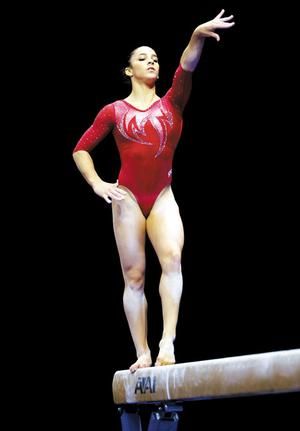Sport and Competition
Reading Olympic Bodies
Female gymnasts are pin-up girls of the summer games
Posted August 1, 2012

When it comes to the Olympics, there is no shortage of astonishingly honed bodies doing incredible, improbable things for us to admire. Along with their remarkable stamina, talent and commitment, it is the athletes’ bodies that mesmerize. They telegraph, “We are not like you.” The long-limbed runners, god and goddess-like divers and Amazonian female volleyball players astonish us with their abilities—and the way that they look.
As we gaze upon their remarkable bodies, we may all, to some extent, rehearse what psychoanalysts and film and social theorists have termed “scopophilia.” The word, often used interchangeably in social theory with “visual pleasure,” is a translation of Freud’s term schaulust, a love of looking and watching that he believed all children feel. This impulse, Freud suggested, was normal and could be sublimated into, say, an appreciation of art or, if not sublimated, could become a fetish or fixation.
Film and social theorists have further suggested that scopophilia is “gendered,” with men as bearers of “the gaze,” and women its (passive) recipients. In movies, soap operas, beauty pageants or even day-to-day life on the street, they suggest, we see a demonstration of all the ways women are uniquely “to-be-looked-at” in our culture and have a special, privileged relationship to display. Hence the billions of makeup and fashion options for women, while men just get shaves and wear suits. Hence, the Peep Show. And so on.
At the Olympics, where opportunities for scopophilia abound, it is perhaps female figure skating in the winter games, and women’s gymnastics in the summer ones that provide the most compelling and sumptuous visual pleasures of all. The sparkly, figure-hugging outfits telegraph “pin up girl” and “athlete” at the same time. Most recently, “The Fierce Five” (a term they are said to prefer to “The Fab Five”) was in our sights. The U.S. women’s gymnastics team vaulted (and balanced and tumbled and uneven parallel-barred) their way to the gold after a much ballyhooed moment when team member Jordyn Wieber learned she would not be able to compete as an “all-around” and broke down in tears. She and her teammates are clear winners in every way, not least of all because theirs is a delicate cultural balance. Like figure skaters, gymnasts must embody “femininity” and “artistry” while also being full-on, all-out, aggressively athletic jocks. They must be graceful and attractive and telegenic, and also have killer competitive instincts, macho tumbling skills, and the fearlessness to push their bodies to do dangerous and counter-intuitive stunts.
Their mind-boggling flexibility, the hyperextension of their arched backs, their graceful calf muscles all telegraph a to-be-looked-at-ness that men and women alike may well enjoy, it is true. But we also love that these Olympiads are strong, competent, and too tough to crack under pressure. In this way suggests Rachel Blakeman, JD., LCSW-R, a psychoanalyst and psychotherapist in Manhattan who has worked with a number of female competitive athletes, actors and models, the Fierce Five are Everywoman….times a million:
“Many women struggle with maintaining a sense of themselves as feminine while embracing the aggressive and competitive strivings that allow them to succeed. Women grapple with reconciling the cultural perceptions of femininity while success in certain areas of their lives requires them to engage in activities that are traditionally considered masculine. The Olympic gymnasts must literally embody all of these traits at all times. There is no room for internal conflict when pursuing a goal like the Olympic gold medal.”
So when you see Gabby Douglas or Kyla Ross looking pretty in a shampoo commercial down the line, don't be fooled.


